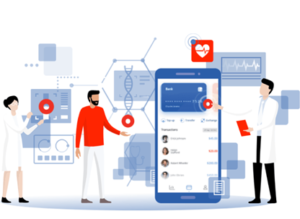
บทความโดย มร.มาร์ค วีเซอร์ รองประธานประจำภูมิภาคเอเชีย-แปซิฟิก เอาท์ซิสเต็มส์
การมอบประสบการณ์ที่ดีให้แก่ลูกค้า (Customer Experience – CX) เป็นภารกิจสำคัญสูงสุดอย่างหนึ่งของธุรกิจวันนี้จากการติดต่อสื่อสารและธุรกรรมออนไลน์ที่เพิ่มปริมาณและความถี่สูงขึ้น อย่างไรก็ตามในส่วนของธุรกิจด้านการดูแลสุขภาพ (Healthcare) ยังไม่ปรากฎว่ามีความคิดริริเริ่มในการปรับปรุงประสบการณ์ของลูกค้า (CX) อย่างจริง ๆ จัง ๆ ทั้งที่ระบบสาธารณสุขทางไกล (Telehealth) มีการปรับใช้เพื่อรองรับการตรวจสุขภาพและการรักษาพยาบาลผ่านระบบออนไลน์เพิ่มมากขึ้น ขณะที่คุณอาจรู้สึกพอใจเมื่อเข้ารับบริการที่สถานพยาบาล แต่บริการรูปแบบนี้ยังมีช่องโหว่ที่เห็นได้ชัด กล่าวคือมีผู้บริโภคเพียง 34% เท่านั้นที่รู้สึกว่าตนเองได้รับข้อมูลที่ต้องการ และ 56% ไม่คิดว่าตนเองได้รับการดูแลรักษาที่มีคุณภาพเทียบเท่ากับการไปพบแพทย์ที่โรงพยาบาลโดยตรง[1]

แน่นอนว่าธุรกิจการดูแลสุขภาพจะได้รับประโยชน์อย่างเป็นรูปธรรมจากการปฏิรูปด้านประสบการณ์ของลูกค้า (CX) ครั้งใหญ่ และที่จริงแล้ว 1 ใน 5 ของผู้บริโภคที่บอกว่าจะไม่รับบริการรักษาพยาบาลทางออนไลน์อีก ไม่ชอบวิธีที่แพทย์และพยาบาลปฏิบัติต่อเขา หากการแพร่ระบาดที่เกิดขึ้นทั่วโลกเป็น “ปัจจัยหลัก” ผลักดันให้องค์กรธุรกิจเร่งปรับใช้ระบบดิจิทัล ปัจจัยนี้เองก็น่าจะสร้างแรงกระตุ้นให้กับธุรกิจการดูแลสุขภาพในลักษณะเดียวกัน โดยในการให้บริการด้านสุขภาพสถานพยาบาลต้องให้ความสำคัญกับผู้ป่วยหรือคนไข้เป็นหลัก และเน้นการตอบสนองความต้องการของผู้ป่วย
ทุกวันนี้ ผู้บริโภคมีความใส่ใจและมีความรู้ด้านสุขภาพเพิ่มมากขึ้นอย่างที่ไม่เคยมีมาก่อน พวกเขาต้องการบริการอย่างมืออาชีพและโปร่งใส ในราคาเหมาะสม และปรับให้สอดรับกับความต้องการของแต่ละบุคคลตัวอย่าง คน Gen X กับ Baby Boomers มีความสนใจเพิ่มมากขึ้นเกี่ยวกับแอปในกลุ่ม Telehealth ที่ให้คำแนะนำแบบเรียลไทม์สำหรับการคัดกรองผู้ป่วย ส่วนหนึ่งเป็นผลมาจากสถานการณ์การแพร่ระบาดที่เกิดขึ้นทั่วโลก การที่แอปดังกล่าวได้รับความสนใจอย่างกว้างขวางส่งผลให้การขอรับบริการทางการแพทย์ผ่านระบบออนไลน์เพิ่มขึ้นจาก 15% ในปี 2562 เพิ่มเป็น 28% ในเดือนเมษายน ปี 2563[2] อย่างไรก็ตาม สิ่งที่ยังเหมือนเดิมคือ ความคาดหวังต่อความสัมพันธ์ที่ดีและความน่าเชื่อถือระหว่างแพทย์และผู้ป่วย ที่ยังเป็นเรื่องสำคัญสูงสุดสำหรับผู้บริโภคทั้งในส่วนออนไลน์และออฟไลน์

เพื่อตอบสนองต่อความคาดหวังสูงของผู้บริโภคได้ดียิ่งขึ้น สถานพยาบาลต้องสร้างการติดต่อสื่อสารที่เหมาะสมระหว่างผู้ป่วย แพทย์และพยาบาล โดยมุ่งเน้นประสบการณ์ของลูกค้า (CX) เป็นหลักของ Initiative การเปลี่ยนย้ายไปสู่รูปแบบการดูแลสุขภาพโดยเน้นคุณค่า (Value-Based Care – VBC) จะช่วยปรับปรุงประสิทธิภาพในการดูแลรักษา ลดต้นทุนและค่าใช้จ่ายโดยรวมในการให้บริการ และลดค่าใช้จ่ายสิ้นเปลือง[3] แพลตฟอร์มดิจิทัลจะช่วยรองรับแนวทางการรักษาพยาบาลแบบครบวงจรนี้โดยอาศัย:
- ระบบวิเคราะห์ข้อมูลก้าวล้ำที่ช่วยปรับปรุงการดูแลรักษาผู้ป่วย
- การปรับปรุงประสิทธิภาพด้านการรักษาพยาบาล โดยใช้ข้อมูลที่โปร่งใส
- การเพิ่มความคล่องตัวในการดำเนินงาน รองรับการให้บริการนอกสถานพยาบาล
- การปรับแต่งประสบการณ์แบบเฉพาะบุคคลสำหรับผู้ป่วย
ระบบวิเคราะห์ข้อมูลก้าวล้ำที่ช่วยปรับปรุงการดูแลรักษาผู้ป่วย
ผู้ป่วยจะได้รับประโยชน์อย่างมากจากระบบดิจิทัลแบบครบวงจรที่รองรับการใช้ข้อมูลร่วมกันระหว่าง
ผู้ให้บริการด้านการดูแลสุขภาพ การเข้าถึงข้อมูลจำนวนมหาศาลที่ครอบคลุมทั้งในส่วนของระบบรักษาพยาบาล ระบบปฏิบัติงาน ระบบบริหารจัดการและแผนกต่าง ๆ รวมถึงข้อมูลจากองค์กรอื่น จะช่วยให้องค์กรที่ให้บริการสุขภาพ (Healthcare Delivery Organization – HDO) สามารถตรวจสอบประวัติด้านสุขภาพของผู้ป่วยได้รอบด้าน 360 องศา ตัดสินใจได้อย่างถูกต้องและให้มาตราฐานการดูแลในระดับสูงโดยอ้างอิงจากข้อมูล ซึ่งทั้งหมดนี้จะช่วยลดความซ้ำซ้อนของการตรวจวินิจฉัยและการรักษาพยาบาลผู้ป่วยที่มากเกินความจำเป็น และสร้างความพึงพอใจในการรับบริการได้ดีขึ้น
การปรับปรุงประสิทธิภาพด้านการรักษาพยาบาล โดยใช้ข้อมูลที่โปร่งใส
ความสามารถในการผสานรวมแหล่งข้อมูลและระบบต่าง ๆ เข้าไว้เป็นแหล่งข้อมูลหนึ่งเดียวจะช่วยเพิ่มประสิทธิภาพและลดข้อผิดพลาดด้านการรักษาพยาบาลอย่างมีนัยสำคัญ อย่างไรก็ดีระบบที่สถานพยาบาลใช้งานอยู่จำนวนมากยังคงมีข้อจำกัดในเรื่องความโปร่งใสและการแลกเปลี่ยนข้อมูลระหว่างแผนกต่าง ๆ
ถ้าหากแพทย์สามารถตรวจสอบข้อมูลผู้ป่วยจากแผนกต่าง ๆ ได้อย่างพร้อมสรรพและรอบด้าน ก็จะสามารถทำการตัดสินใจได้อย่างถูกต้องเหมาะสม โดยอาศัยข้อมูลแบบเรียลไทม์ที่ครบถ้วนสมบูรณ์ 100%
การเพิ่มความคล่องตัวในการดำเนินงาน รองรับการให้บริการนอกสถานพยาบาล
ถ้าสถานพยาบาลมุ่งเน้นการให้บริการโดยยึดผู้ป่วยเป็นศูนย์กลาง ก็จะสามารถลดค่าใช้จ่ายในการดำเนินงานและให้บริการแก่ผู้ป่วยตามบ้านได้อย่างมีประสิทธิภาพ การสร้างโซลูชั่นการให้บริการรักษาพยาบาลแบบหลายช่องทางสำหรับผู้ป่วยและแพทย์ (เช่น ระบบ Telehealth, การจัดการการดูแลรักษาผู้ป่วยภายในบ้าน, โมบายล์แอปด้านการดูแลสุขภาพ) จะช่วยให้สถานพยาบาลสามารถสร้างระบบต้นแบบได้อย่างรวดเร็ว ทดสอบกับผู้ใช้ และปรับเปลี่ยนได้อย่างฉับไวภายในเวลาไม่กี่ชั่วโมง
การปรับแต่งประสบการณ์แบบเฉพาะบุคคลสำหรับผู้ป่วย
การนำบทเรียนที่ได้รับจากประสบการณ์ของลูกค้าในอุตสาหกรรมอื่น ๆ มาปรับใช้จะช่วยสร้างระบบดิจิทัลใหม่ ๆ ให้กับสถานพยาบาลให้สามารถพัฒนาแอปสำหรับผู้ป่วยได้อย่างรวดเร็ว เพื่อรองรับวัตถุประสงค์ต่าง ๆ เช่น การศึกษาวิจัยเกี่ยวกับยาที่จ่ายให้ผู้ป่วย การประเมินทางเลือกในการรักษา การเข้าถึงและควบคุมข้อมูลทางการแพทย์ เป็นต้น
การสร้างสรรค์นวัตกรรมที่รวดเร็วสำหรับระบบการแพทย์ดิจิทัล, การติดต่อสื่อสารกับผู้บริโภคผ่านช่องทางดิจิทัล, AI และบริการดูแลสุขภาพทางออนไลน์ ทำให้เกิดความเปลี่ยนแปลงครั้งใหญ่ต่อธุรกิจและรูปแบบ
การดำเนินงานแบบเดิม ๆ ของผู้ให้บริการสุขภาพ การปรับตัวเพื่อรับมือกับกระแสความเปลี่ยนแปลงเหล่านี้ โดยนำเสนอรูปแบบการให้บริการสุขภาพแบบครบวงจร ถือว่ามีความสำคัญอย่างมากต่อธุรกิจการดูแลสุขภาพ เพื่อให้สามารถแข่งขันได้อย่างมีประสิทธิภาพในสังคมดิจิทัลที่ให้ความสำคัญกับผู้บริโภคเพิ่มมากขึ้น
นอกเหนือจากการปรับเปลี่ยนการดำเนินงานสู่ดิจิทัล (Digital Transformation) แล้ว การเปลี่ยนผ่านองค์กรไปสู่ดิจิทัลก็มีความสำคัญเช่นกัน โดยจำเป็นที่จะต้องปรับเปลี่ยนวิธีคิดและมุมมองในการพัฒนากลยุทธ์สำหรับธุรกิจดิจิทัล รวมถึงสถาปัตยกรรมไอทีขององค์กร พร้อมทั้งกำหนดแนวทางการดำเนินงานที่มีประสิทธิภาพ นอกจากจะต้องปรับตัวให้สอดรับกับสถานการณ์แล้ว ผู้ให้บริการสุขภาพยังต้องปรับปรุงแผนพัฒนาระบบดิจิทัล โดยจะต้องมุ่งเน้นการยกระดับประสบการณ์ดิจิทัลสำหรับผู้ป่วยและบุคลากรทางการแพทย์ การพัฒนาไปสู่แนวทางที่มุ่งเน้นประสบการณ์ที่ดีของลูกค้า (CX) นี้มีความสำคัญเพิ่มมากขึ้นในสถานการณ์ปัจจุบันซึ่งมีการแพร่ระบาดเกิดขึ้นอย่างต่อเนื่อง มาตรการล็อคดาวน์และข้อจำกัดด้านความปลอดภัยที่มีผลบังคับใช้ทั่วโลกอาจทำให้เราต้องเปลี่ยนมาใช้ช่องทางออนไลน์สำหรับการขอคำปรึกษาจากแพทย์ในอนาคตอันใกล้เร็วกว่าที่เราคิดไว้ และเราควรจะมั่นใจได้ว่าสุขภาพของเราได้รับการดูแลเป็นอย่างดีโดยบุคลากรที่มีความเชี่ยวชาญอย่างแท้จริง
[1] 2020 Health care consumer survey: consumer health trends
[2] 2020 Health care consumer survey: consumer health trends
[3] OutSystems for Healthcare – Accelerate Delivery of Value-Based Care
